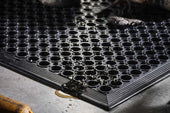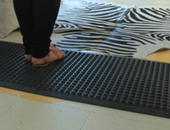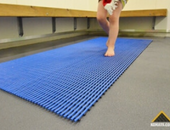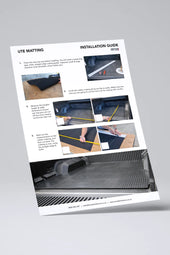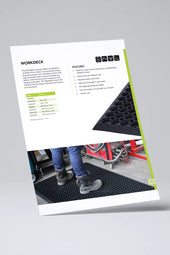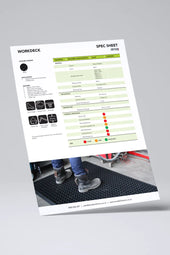Schools across Aotearoa face daily safety challenges in their facilities. That’s why well-placed mats are a vital investment—they effectively reduce slips, trips, and even fatigue among students and staff.
But this is another expense for our school—are they really worth it?
Feedback from our clients says one simple thing… yes, they are!
Although mats represent another expense, they pay off in safety benefits and cost savings. With rising costs for labour and materials, even small increases in cleaning expenses can strain a school’s finances.
By strategically using mats to prevent accidents and reduce wear and tear on floors, schools can better protect their communities while keeping overall maintenance costs in check. If you’d like to explore further how installing mats can enhance safety and efficiency, read on!
What is the Purpose of a Mat in Schools?
Mats add protection underfoot by reducing slips and wear on floors. They also help collect dirt, moisture, and tiny particles so they do not spread across hallways and classrooms.
Why Do We Need Mats?
Mats are a simple way to keep students safer since dry and clear floors mean fewer mishaps. They can also lessen the workload of maintenance teams and protect floors from everyday foot traffic.
By installing mats for schools, we create an environment where staff and students can move around without any worry. Look at them as an easy fix for issues caused by wet shoes, spilt liquids, and other messes that appear during the school day.
Benefits of Having Mats in Schools
-
Enhances safety: They reduce slips in spots where water or other substances might build up.
-
Improves air quality: They help hold dust particles, which can lower the amount of airborne debris in busy areas.
-
Traps dirt: They capture soil and moisture before it spreads across floors.
How Do Matting and Carpets Save Schools Money?

Mats and carpets are practical tools that stop floors from wearing out too soon. They also help reduce upkeep needs, which can save quite a bit of cash over time.
Lower Accident Risks
Water and dirt on floors can raise the odds of slips. Students who move from sports fields or outside areas often track in bits of mud and moisture. Mats help keep these messes near the door, reducing the chance of accidents.
By investing in matting solutions, you cut the odds of costly claims and medical bills. Plus, healthy and happy students and staff mean the school day runs more smoothly.
Reduced Cleaning Costs
When mats are used at main entries, dust, soil, and moisture are confined near doorways. As a result, the frequency of deep cleaning is reduced. Fewer clean-up procedures mean maintenance staff have more time for other projects.
By catching dirt early, the school’s floors stay nicer for longer, requiring fewer major wash-downs or replacements. This is one of the ways that mats for schools help administrators keep a close eye on spending.
Improved Indoor Air Quality
Mats attract dust and other fine particles, limiting their movement within the building. This creates a better breathing setting for students and reduces irritants that can trigger health problems.
When mats are placed in entry areas and classrooms, they help make the entire school feel fresher. This benefit is often overlooked, but it can have a positive effect on everyone’s daily comfort.
What Kind of Flooring is Best for Schools?

Many schools pick flooring based on cost and maintenance needs. Different materials suit various parts of campus, so deciding where to place mats can improve budgets even more.
Which Materials Are Used for Mats?
-
Carpet: Offers a softer surface and helps with sound control.
-
Vinyl: Simple to wipe clean and popular for corridors.
-
Tile: Long-lasting and often used in labs or kitchens.
Choosing the Right Material for Different School Areas
-
Entrances: Rubber or a carpet mix can handle weather and heavy traffic.
-
Hallways: Vinyl mats that resist wear can cope with daily foot activity.
-
Classrooms: Carpet-style mats for schools offer extra comfort and reduce noise.
How Many Types of Mats Are There?
There are many different styles on the market, but most fall into a few main groups. It depends on the function, the zone, and the type of material needed.
Entrance Mats
These are placed at doors and lobby areas to gather debris as people walk in. We use them to reduce wet spots on floors that might cause slips. They also help lower the spread of dust, keeping classrooms and hallways clearer.
Some of the most popular products of entrance mats include:
Deck Matting
These mats are commonly placed in outdoor areas such as decks, walkways, or entrances that see frequent foot traffic and are exposed to the elements. Their textured design helps water drain away, minimising slip hazards and improving overall safety.
On top of this, because of drier surfaces, deck matting cuts down on maintenance time and helps preserve the integrity of the flooring underneath.
Some of the most popular products of deck matting include:
-
Ako Safety Matting (Popular Non-Slip Deck Matting)
-
Nordic Marine Carpet (Outdoor Marine Carpet roll)
-
Stair Nosing (Fibre Glass Stair Nosing)
Anti-Fatigue Mats
These products cushion the feet and legs of people who stand for a good portion of the day. School staff in labs, front desks, or cooking rooms may benefit from them. Proper support eases leg and foot strain.
Wet Area Mats
These are set near swimming pools, changing rooms, or cafeterias where moisture is more common. Their slip-resistant design helps manage water buildup. This also cuts down on extra cleaning by limiting the spread of liquid across floors.
Why Schools Need a Proper Matting System
The number one reason why schools need to have proper matting systems is that they improve the overall safety of a school’s walkways and rooms. As an added benefit, they also help keep floors nice and cut overall maintenance costs.
Purposes of Different Mats in Schools
We choose specific mats for main doors, classrooms, and hallways.
Entrance mats hold onto moisture, which is great for stormy days. Meanwhile, mats for school classrooms can keep floors from getting scratched by chairs and other items. Hallways that get a lot of foot traffic might require a heavier type of mat to stand up to daily wear.
By mixing various mats in key places, the school can create a tidy environment that demands less upkeep and is an overall safe space for students and staff.
The Role of Anti-Fatigue Mats for Schools
Teachers and staff who stand for long periods can benefit from mats that offer cushioned support. Anti-fatigue mats help reduce strain on joints, making it simpler for them to focus on tasks.
Science labs, admin spaces, and other areas where staff stand for extended periods can benefit from these mats. Over time, this small comfort often boosts morale and reduces soreness.
How Entrance Mats Improve Safety and Hygiene in Schools
Even a bit of rain can bring a puddle of water indoors. Proper mats help keep that moisture under control, which is helpful for day-to-day floor safety.
Why Are Safety Mats Important in Schools?
When wet boots and shoes come in contact with hard floors, accidents can happen. Mats near doors reduce the chance of slips and help contain mud and moisture.
This not only lowers cleaning tasks but also keeps floors looking tidy. By keeping water and dirt near the door, schools also lower the spread of allergens that can affect staff and students.
How Do You Take Care of a Mat?

Mats are not a one-time purchase. Regular upkeep is needed so they keep working well and do not become grimy or worn.
Best Practices for Mat Cleaning and Maintenance in Schools
-
Vacuum daily: Go over the surface to remove dirt that has settled. This helps the mat maintain its dirt-catching abilities and keeps it looking tidy.
-
Shake or brush outside: If possible, shake mats outdoors to dislodge deeper particles. This lowers the dust that gathers within the fibres.
-
Spot-treat stains: Address any spills right away by blotting and cleaning the patch. A quick response keeps stains from settling in and reduces odours.
-
Use mild cleaning products: Stick with simple cleaners that do not harm the mat. This choice prevents the mat from wearing out too early.
-
Check corners and edges: Over time, corners might start to curl. Straighten them when you see it so the mat stays in place and reduces tripping.
Extending the Lifespan of Custom Mats and Entrance Mats
-
Rotate mats in busy spots: Shifting entrance mats or other mats to different areas can balance wear.
-
Allow mats to dry fully: If they get soaked, hang them to dry so the backing does not weaken.
-
Schedule inspections: A quick look each term helps spot damage early so you can replace or repair it before bigger problems arise.
Keeping Schools Safe Without Breaking the Bank
Costs can add up if schools do not manage cleaning routines and floor upkeep in a thoughtful way. By using mats for schools, we help stop wear on floors and reduce slip incidents, which lowers expenses in the long term. A reliable matting system cuts down on safety issues, and as an added bonus, you get to have lower costs on daily floor maintenance.
Through well-placed commercial mats, along with mat cleaning schedules, your school can run more smoothly. You can also save on unexpected repairs when floors hold up better over time. We recommend looking into matting solutions that suit your needs, including anti-fatigue mats or custom mats, as part of a plan to boost workplace safety and comfort.
By taking this step, you can set aside more resources for core school activities and keep your community happy while doing so. Feel free to talk with our team about mats for schools that meet the demands of your campus.


